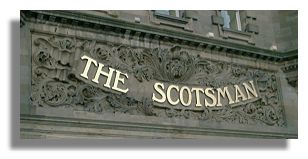
The Scotsman Newspaper

The Scotsman newspaper is a quality broadsheet newspaper which (like its rival, the Glasgow-based Herald) has contributed much to the culture of Scotland. Here is a brief history of the paper by journalist Vivien Devlin.
The Beginning
Most appropriately the Scotsman was launched on 25th January, Robert Burns's birthday, in 1817. Founded by two determined, opinionated men, William Ritchie, a solicitor and Charles Maclaren, a customs official who felt there was no public platform for independent, outspoken views. Ritchie had wished to write a story about the mismanagement of the new Royal Infirmary which the city newspaper refused to print. The answer was to publish such stories himself and The Scotsman began as a weekly Saturday paper, at a cost of tenpence, including 4d stamp duty. With a Liberal standpoint it aimed to offer, "impartiality, firmness and independence". The estimated circulation was 300 copies but soon interest grew and a Wednesday edition was also published.
There were however a few enemies, such as the several indignant Town councillors and a Scottish lord, who described it as "that incendiary newspaper". Co-editor Maclaren strengthened the Scotsman's editorial viewpoint by supporting parliamentary reform, Catholic emancipation and other national controversies such as the Disruption in 1843 over the right of Church of Scotland congregations to choose their minister (illustrated here).
Increased sales took off in 1855 when advertisement and newspaper stamp duty were abolished. The Daily Scotsman was published, priced at one penny, with front page advertisements and a circulation of 6,000 copies. Ten years later the "daily" was dropped and sales increased to 17,000 a day.
Edinburgh Roots
The Scotsman was mainly an Edinburgh paper and while stage coaches delivered the paper further afield it was the railway which developed circulation even more. From 1865 the Scotsman made a deal with the railway companies to carry the paper for a carriage fee.
Within a few years it became the first British paper to run special early morning high -speed trains from Edinburgh to Glasgow. Loaded at Waverley Station the train had a carriage bearing the newspaper's livery and during the journey west, packers made up parcels which were thrown out at various stations en route. The time lapse from publication to arrival in Glasgow was only 70 minutes so that Glaswegians could sit down over breakfast to read their copy at the same time as those in Edinburgh.
The original Scotsman office was at 347 High Street later moving round the corner to Cockburn Street, regarded as the finest in Britain. With increased sales and profitability, the proprietors decided to finance a purpose built publishing house. At the end of the 19th century the North Bridge was being widened to create a more practical gateway for traffic between the old and new town. The new, lavish Gothic style, 190 foot high Scotsman office was built on the prime location on North Bridge at a cost of £500,000 and opened in 1905. No expense was spared and magnificent marble staircases, pillar, mahogany and walnut panelled walls, ornate ceilings were designed for the public areas and editor's office - with needless to say, plain, more functional rooms for journalists and staff.
A 21st Century Newspaper
Fifty years later, with front-page news taking the place of advertisements the Scotsman was a truly modern newspaper, gaining many awards and continuing to increase readership to around 70,000. In the 1960s, it was the first to publish a separate Saturday a literary, culture and educational supplement, which proved to be an innovative and popular decision. Lord Francis-Williams wrote in the New Statesman:
"One of the best written, best produced and in many ways the most civilised newspaper in Britain".
By the end of the century, the rambling old building on North Bridge with its labyrinthine corridors across thirteen floors, in two separated wings, was inappropriate for a modern newspaper. Together with the sister papers, Scotland on Sunday and the Evening News, a new purpose-built office was built on Holyrood Road, near to the proposed site of the Scottish Parliament. Three floors high, it features spacious open plan offices for a staff of 600, grouped together by department. The beautiful rounded building is designed in light wood and plenty of glass to emphasise the use of natural light.
In its 185th year, the Scotsman moves on to the next phase of its development, continuing to be contemporary and innovative - ahead of the pack in developing an internet presence in 1999, later developed into a major website, Scotsman.com. Changes in location and technology aside, perhaps the paper still stands by Lord Cockburn's comment: "the first Scotch newspaper that combined independence with intelligence and moderation with zeal."
Where else would you like to go in Scotland?

